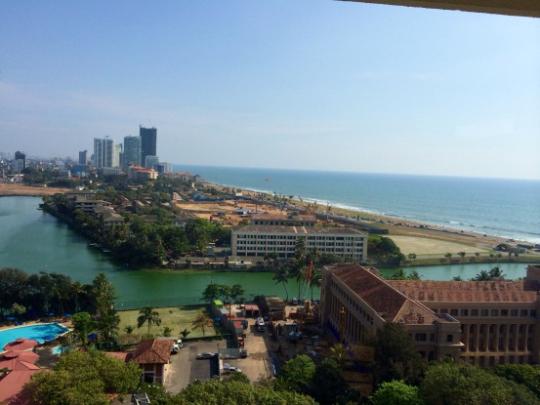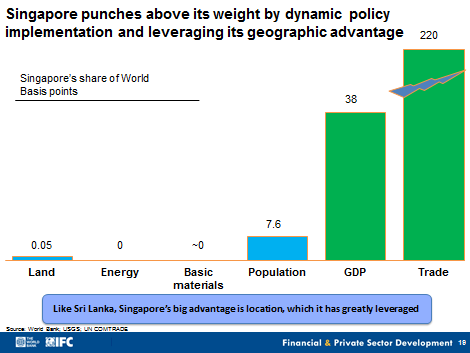Sri Lanka conjures up different images in the minds of different people: lush green tropical canopies, steaming cups of aromatic tea, and hardworking fishermen in their dinghy boats.
For me, the country also packs enormous promise for growth and development. There is not the slightest doubt that Sri Lanka will have to come clean and deal with the aftermath of its prolonged civil war. However, at a fundamental level, there is a sense of hunger in its people to rebuild their lives and their country. The new-found peace that engulfs the population is cherished by most, and is part of dinner conversations especially with foreigners like me.
Sri Lanka already holds a strong position in certain agricultural and industrial exports, like tea or uncut diamonds. Combine this with its strategic location – situated at the crossroads of major shipping routes connecting South Asia, East Asia and the Middle East – and you have a potent combination, a promise waiting to be fulfilled.
I recently spoke at an event organized by the country’s top business newspaper, the Daily Financial Times, in partnership with the well-regarded Colombo University MBA Alumni Association. The focus of the forum was the country’s emerging six-hub strategy – Maritime, Commercial, Knowledge, Aviation, Energy and Tourism: the cornerstone of its further economic development.
The euphoria leading up to the event was palpable. The ceremonial drums and lighting of the auspicious lamp to evoke good omen created the perfect ambience. I was nervous, not because of stage fright, but because I was about to present a contrarian viewpoint to private-sector and public-sector experts, while sharing the stage with the Minister of Economic Development and the Governor of the Sri Lanka’s Central Bank. Even though my arguments were well-thought-through and fact-based, it was going to be a delicate dance, as I was about to communicate some tough arguments against the implementation of the full-blown six-hub strategy.
Sri Lanka has rebounded after the civil war with strong growth. The unemployment rate is at a historical low, and the country has reasonably strong ratings in the Global Competitiveness Index, the World Bank Group's "Doing Business" rankings and the Human Development Index.
This is the good news. The bad news is that growth has been largely fueled by public investments, with a very slow increase in private investments, only a slight increase in foreign direct investment (FDI), and reduced export competitiveness. The country has also suffered a decline in absolute export earnings in key commodities, such as tea, natural rubber, textiles and garments.
The really good news, I believe, is that there is significant headroom for long-term growth. One does not have to look far and wide for the opportunities for quick wins.
There is strong potential to increase the port shipping volume or air passenger traffic vis-à-vis comparable countries. Another opportunity stems from the fact that Sri Lanka’s score on the tourism competitiveness index is 101 – compared to 80 for Vietnam and 10 for Singapore. However, the tourist arrivals in the country are 1 million per year, as compared to around 7 million for Vietnam or 14 million for the tiny Singapore.
What more can Sri Lanka do? I shared four suggestions:
- The five pillars of competitiveness – regulatory environment, infrastructure, access to finance, skills and capabilities, and technology and innovation – need to be improved on a continual basis and in an integrated manner.
- Launching all six hubs simultaneously will be highly demanding on the still-fragile government infrastructure. The country should prioritize, focusing over the first three years on two hubs – for example, maritime and tourism – with clear milestones and checks and balances. It should later move on to the others in a phased manner, and with transparent processes.
- Cross-cutting initiatives that support more than one hub need to identified and launched – for example, vocational training institutes that support more than one industry.
- The country should use the opportunity to learn from the failures and successes of others. East Asia has done well in a private-sector-led approach to development. Singapore and Malaysia are two very good examples to benefit from.
The World Bank Group’s Lessons Learned in Enhancing Competitiveness – my checklist
The following items could help each of Sri Lanka’s six hubs to figure out what makes sense for them, and what doesn’t:
- Smart design: This is key. Singapore’s Jurong Island, a petrochemical hub, is an example of a hub designed to house some of the top petrochemical and related firms on one island, cutting down the cost of operations, transportation and logistics. Given its design, almost everything coming out of the island has a greater margin than similar outputs manufactured anywhere else.
- Tango between the public and private sector: Like in many countries, this seems to be lacking in Sri Lanka. Examining PEMANDU in Malaysia – the Performance Management and Delivery Unit – which actively and successfully engages both the private and public sectors, could bring useful insights. Sri Lanka could explore establishing a central agency, with vision and authority, tasked with monitoring and delivery of industrial roadmaps that are currently being designed.
- Clear rules and processes, along with transparent execution: A radical and transformational approach is required. Again, the central agency mentioned above could be made responsible for this.
- Coordination at multiple levels: Coordination between the macroeconomy and policy levels, and between the mezzo (clusters, hubs and value chains) and firm-level efforts. The country would benefit from a deeper mindset and incentives to collaborate.
- Accountability and performance measurement: There should be specific targets for agencies, along with performance-linked bonuses and marked-to-market public-sector salaries. Investments in ongoing monitoring and evaluation and a project management office would also bode well.
Valuable Lessons from Singapore
One thing that Singapore does extremely well is "market sensing." Policies are designed market-backwards rather than supply-forwards. This translates into rethinking the country’s economic focus every five to seven years. This has helped Singapore move from an import-substituting economy some 50 years back, to focusing on innovation- and technology-based industries today – which has helped it increase its GDP per capita 80 times along the way. The country also has clear rules and processes and transparent execution.
In the last five to seven years, Singapore has made significant changes in certain policy dimensions, its educational institutions, and its investment portfolio to have a positive impact on its sunrise industries. It has recently created three clusters:
- Biopolis – biomedical R&D facility
- Fusionopolis – dedicated to R&D in the Infocomms, Media, Science and Engineering industries
- Mediapolis – self-contained digital media cluster
In these three clusters, private-sector research labs are co-located with public-sector research institutes. Moreover, incentives are provided to attract entrepreneurs, academics and scientists to pursue research and development in Singapore. There is a simultaneous push for commercialization of promising technologies. What undoubtedly helps is the fact that the governance structure of Singapore is quite robust, so one can do these things and avoid the risk of "industry capture" and corruption issues for the most part – something to consider when thinking about clusters in Sri Lanka.

And, finally, Singapore has a negligible land mass and zero energy resources, yet it commands 2.2 percent of global trade – an outperformance that is astonishing. Sri Lanka is better-endowed and better-located than Singapore, so its potential for growth is phenomenal.
It is not a surprise that the resplendent island of Sri Lanka is raring to deliver. I believe it is very well positioned to succeed. The time is now to adapt successful solutions while learning from and avoiding the mistakes of some of its very successful neighbors in the region.



Join the Conversation